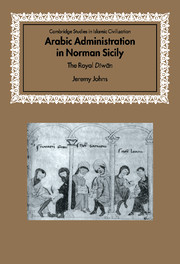Book contents
- Frontmatter
- Contents
- Preface
- Tables
- Abbreviations
- Genealogical table of the De Hautevilles of Sicily
- Note on Measurements
- Introduction
- 1 ‘In the time of the Saracens …’
- 2 ‘When first the Normans crossed into Sicily …’
- 3 ‘Our lady, the Regent Adelaide, and our Lord, the Count Roger, her son’, 1101–30
- 4 The earliest products of the royal dīwān, 1130–43
- 5 The jarāʾid renewed, 1144–5
- 6 The records of the royal dīwān. Part I: the jarāʾid al-rijāl
- 7 The records of the royal dīwān. Part II: the dafātir al-ḥudūd
- 8 The duties and organisation of the royal dīwān, 1141–94
- 9 ‘The people of his state’. The ‘palace Saracens’ and the royal dīwān
- 10 The Norman dīwān and Fāṭimid Egypt
- 11 Royal dīwān and royal image
- Appendix 1 Catalogue of dīwānī documents
- Appendix 2 Provisional catalogue of private documents
- Appendix 3 Abū Tillīs – ‘Old Wheat-sack’
- List of References
- Index
- Titles in the series
4 - The earliest products of the royal dīwān, 1130–43
Published online by Cambridge University Press: 10 March 2010
- Frontmatter
- Contents
- Preface
- Tables
- Abbreviations
- Genealogical table of the De Hautevilles of Sicily
- Note on Measurements
- Introduction
- 1 ‘In the time of the Saracens …’
- 2 ‘When first the Normans crossed into Sicily …’
- 3 ‘Our lady, the Regent Adelaide, and our Lord, the Count Roger, her son’, 1101–30
- 4 The earliest products of the royal dīwān, 1130–43
- 5 The jarāʾid renewed, 1144–5
- 6 The records of the royal dīwān. Part I: the jarāʾid al-rijāl
- 7 The records of the royal dīwān. Part II: the dafātir al-ḥudūd
- 8 The duties and organisation of the royal dīwān, 1141–94
- 9 ‘The people of his state’. The ‘palace Saracens’ and the royal dīwān
- 10 The Norman dīwān and Fāṭimid Egypt
- 11 Royal dīwān and royal image
- Appendix 1 Catalogue of dīwānī documents
- Appendix 2 Provisional catalogue of private documents
- Appendix 3 Abū Tillīs – ‘Old Wheat-sack’
- List of References
- Index
- Titles in the series
Summary
After the long interval during which no Arabic documents seem to have been issued to Sicilian recipients, in March 1132, little more than a year after Roger's coronation, Arabic documents suddenly began to be issued again. This is surprising. More than a generation had passed since the completion of the conquest and, in that time, Greek had become firmly established as the primary administrative language of the Norman regime. Greek was used to register Arab villeins, and to describe estate boundaries which proceeded from one Arabic boundary-mark to the next and which had been established on the testimony of Arab witnesses. Greek decrees were issued to royal officials who included Arabic-speakers amongst their number. There is no evidence that such Greek documents had failed to fulfil their administrative function. Latin, too, had gained a toe-hold, although it was only after 1130, and especially after the death of Roger II in 1154, that it was seriously to challenge the pre-eminence of Greek, and eventually to surpass it. What, then, dictated the return to Arabic? We must begin to seek the answer in the documents themselves.
The Cefalù deperdita (Dīwānī 10–11)
The earliest products known to have been issued by King Roger's dīwān were two bilingual documents in favour of the new royal foundation of San Salvatore di Cefalù. Neither survives in its original form.
- Type
- Chapter
- Information
- Arabic Administration in Norman SicilyThe Royal Diwan, pp. 91 - 114Publisher: Cambridge University PressPrint publication year: 2002



